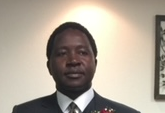Working at the intersection of finance and sustainability
Some of the greatest scientific and technological strides occur when different knowledge bases and skill sets come together in unexpected — and unconventional — ways: NYU Tandon data scientists, roboticists, and biomedical engineers have collaborated to improve healthcare, for example, and our electrical and civil engineers have joined forces to bolster the resiliency of power grids.
Similarly, researchers in the Department of Finance and Risk Engineering (FRE) draw upon computer science, artificial intelligence, and applied mathematics to address financial issues and keep the global markets functioning. “We are a flagbearer for the concept of unconventional engineering,” Department Chair Peter Carr asserts. “Within finance, we have historically offered several unconventional courses, focusing on topics such as cryptocurrencies, cloud computing, and automated differentiation.”
Now, the department is ensuring that its graduates can work at the increasingly important intersection of finance and sustainability.
During the Spring 2022 semester, students will be able to take Tandon’s first-ever course on ESG factors, an acronym that refers to environment (encompassing a company’s carbon footprint and overall sustainability efforts), social (which takes into account hiring practices, diversity, and commitment to the broader good), and governance (the ways in which the company’s board and management seek to encourage positive change and stakeholder satisfaction). With a growing number of investors around the world considering these untraditional metrics during their decision-making process, it's becoming more and more important that financial professionals grasp the complexities of ESG.

The innovative course, FRE-GY 6951 Sustainable Investment, will be taught by new faculty member Bruno Kamdem, whose research explores the institutional and financial risks associated with the climate change crisis. As part of the department’s Brooklyn Quant Experience Lecture Series, Kamdem recently presented a paper that touched upon one of the most dynamic components of sustainable finance: tradable carbon permits.
Governments seeking to reduce pollution, he explained, place a firm limit (or cap) on the amount of greenhouse gases an individual company is permitted to emit; a company that exceeds that amount can face a stiff financial penalty. Those that remain under the cap, however, can auction off their unneeded allowances or bank them for future use, providing a powerful incentive to reduce emissions — particularly as caps are designed to decline over time.
That marketplace is now worth billions of dollars, and in his presentation, Kamdem — who has served as an advisor to the Office of Research, Evaluation, & Statistics at the Social Security Administration and co-founded his own actuarial and consulting firm — described his formulation and pricing of a new carbon auction derivative that deals with the competition-regulation dichotomy involved. (Applying his model to major oil companies showed that the derivative can be used as a cushioning tool for polluting less while also meeting regulatory standards and making money.)
It’s imperative, he asserts, for aspiring financial professionals to be able to quantify ESG factors. “There’s a tremendous amount of data out there,” he says. “I want my students to be able to make sense of it and use it to build financial models that incorporate sustainability-related metrics.”
Given that climate change is already severely impacting economies and financial markets, Kamdem’s course is a timely addition to the FRE curriculum, and Carr foresees more trendsetting developments ahead. “We strongly feel that the success of our program and the flexibility of our degree can be leveraged to introduce unconventional financial engineering courses until they are no longer considered so,” he says.


